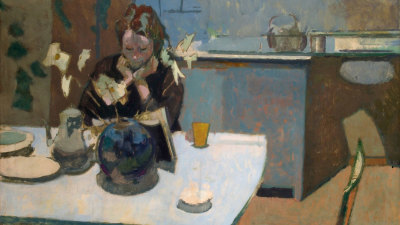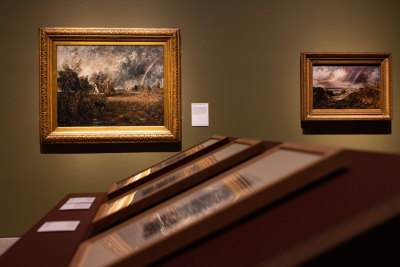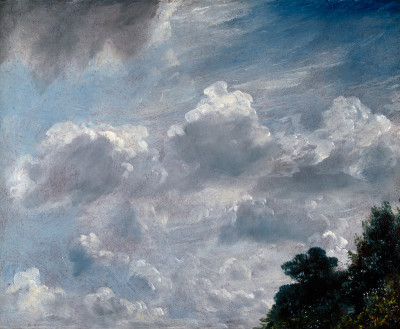Object of the month: December 2015
Object of the month: December 2015
Evelyn Sharp, 'The Child’s Christmas', illustrated by Charles Robinson (1906)
By The RA Collections Team
Published 1 December 2015
By 1880 there was huge competition amongst publishers to employ the best writers, illustrators and designers for books published in the run up to the Christmas holiday.
-
The late-nineteenth century witnessed the boom of the illustrated children’s book market. The rapid development of new printing processes and the great public demand for illustrated material led to the production of more affordable and visually-appealing books, particularly around the holiday season.
By the late nineteenth-century, children’s books had undergone a transformation from instructional manuals intended to instil moral teachings and appropriate behaviour, to lavishly illustrated and ornamented works of art appreciated by child and adult alike as much for their pictorial as well as literary content. Their artistic status was enhanced by the development of colour printing and new methods of printing processes; from the 1870s onwards, the preference for wood-engraving as the traditional method of producing book illustration began to decline in favour of new photomechanical methods of reproduction – these were quicker, cheaper and gave more colourful results.
-

'The Christmas Party', colour line-block reproducing a full-page illustration by Charles Robinson from Evelyn Sharp's 'The Child's Christmas' (1906)

'The Sleigh', colour half-tone plate reproducing an illustration by Charles Robinson from Evelyn Sharp's 'The Child's Christmas' (1906)
-
These technical innovations encouraged the production of the ‘gift-book’, which enjoyed its zenith from the early 1900s until the end of the First World War. It was comparable to today’s coffee-table book: intended for the drawing-room coffee table or nursery shelf, they were designed to be picked up and perused through at leisure, for the appreciation of the whole family; care and attention was paid to the appearance, being bound in fine cloth covers, often with a gold or coloured plate embossed on the front (pictured). Decorated endpapers were common and along with numerous black and white illustrations, coloured plates would be tipped in, printed on a more expensive type of coated paper. They were only illustrated by well-known artists and used to showcase an individual’s work.
The children’s book trade was aimed at the family and the autumn period in particular saw a flurry of publications to capture the holiday market. In the mid-century only a few publishers focused on the Christmas book trade, but by 1880 there was huge competition amongst publishers to employ the best writers, illustrators and designers. The increase of children’s books available at the Christmas period, together with the growing fashion for exchanging gifts, firmly associated children’s books with Christmas. In fact, the publication of children’s books during the holiday season was so prolific that there was a noticeable lack of children’s books produced during the rest of the year!
The Child’s Christmas is an example of the Christmas-themed gift book featuring the new technology of “process” printing. This type of reproduction involved two sorts of illustration from two sorts of block: simple photographic line block for pen and ink drawings and screened illustration in monochrome or colour, known as half-tone. As the first effective photomechanical method of reproduction, line block was a hugely important development (pictured). These new processes allowed a printed result even closer to the artist’s original, contributing to a greater appreciation of an individual artist’s handiwork and their recognition as prominent and popular figures in their own right. Artists enjoyed greater creativity and influence and these developments meant that after 1900 there was no technical reason for any artist to not produce colour illustration.
-

Upper cover and spine of publisher's binding for H.D. Lowry, 'Make-believe', illustrated by Charles Robinson

'In the Toyshop', colour half-tone plate reproducing an illustration by Charles Robinson from Evelyn Sharp's 'The child's Christmas' (1906)
-
Charles Robinson illustrated The Child’s Christmas. One of the most popular illustrators of children’s literature and a key figure during its transformational period from the nineteenth to early twentieth century, he came from a family of illustrators and engravers reaching back two generations. Together with his brothers Thomas and William Heath, also very successful book illustrators, they were known collectively as ‘The Three Musketeers’. Growing up, he was taught the craft by his father and uncle and went on to be apprenticed as a lithographer, but was one of first illustrators to have all his work reproduced by line- and half-tone blocks. He was a devotee to the art of decoration and book design and was strongly influenced by William Morris and Walter Crane; Robinson designed each book as a whole, believing each part of a book from binding to endpapers, was part of the reader’s whole aesthetic experience.
The Child’s Christmas was published by Blackie & Son, one of the most successful publishers for their production of cheaply produced children’s annuals, ranging from sixpence to six shillings for de-luxe volumes, which they excelled in. Charles Robinson produced some of his best work for them. The Child’s Christmas is one such publication, featuring both line block and colour half-tone plate illustrations (pictured).
The book’s author Evelyn Sharp (1869–1955) was a children’s writer and suffragette. She helped found the United Suffragists, one of the main suffrage societies in Britain and was also a key member of the Women’s Social and Political Union. Sharp began her writing career publishing short stories in the infamous Yellow Book, working alongside a group of writers and artists including Oscar Wilde and Aubrey Beardsley.
A major part of her literary output was devoted to children, and she published over twenty books and hundreds of short stories, written to appeal to and engage “the marvellous in their minds”.
December’s artist of the month is Edwin La Dell, printmaker and lithographer. Find out more about the RA Collection.
Prints from A Child’s Christmas can be purchased from the Royal Academy Prints website.







